If you know how to use flashcards in online ESL classrooms, they can be fantastic for memorizing irregular verbs. And they don’t have to be boring, either! Here are my favorite flashy ways to use flashcards in online ESL classrooms.
Why Flashcards?
Let’s cut straight to the obvious: flashcards are for memorizing. As a veteran teacher of adult ESL students, I am painfully (and personally) aware of the less-than-spongy recall functions of the adult brain. Adult learners need more repetition and review than adolescents. Let me say that again if only to prove my point: adult learners need more repetition and review than adolescents.
Younger learners can easily commit new material to memory. The challenge is to make it fun enough to hold their attention. Flashcard activities like the ones below are the perfect answer to memorizing verb forms for all age groups and both online and in-person ESL classrooms.
Do Flashcards Work?
According to Brainscape.com, flashcards have 3 major benefits. They engage active recall, engage metacognition, and allow for confidence-based repetition. Language apps like Memrise are built around these principals because they are scientifically proven to work.
So yes, please use irregular verb flashcards as they were intended to be used: as rote memory tools. But that doesn’t mean they have to be boring! I designed my flashcards with bright, colorful photos and color-coded verb forms so they would make memorizing a little less mechanical and a little more magical. Grab a deck here or make your own and start flipping. Read on for some great activities that are sure to add some flash to your flip.
8 Irregular Verb Flashcard Activities
1. Jazz it up
Grab a metronome or use this drum loop to add a jazzy or hip hop dimension to the chant. Take, took, taken. Students need to get both the rhythm and the tenses correct. Start at about 100 bmp (beats per minute). Challenge students to see how many bpms they can reach without making mistakes.

2. Actor’s Studio
Call out an emotion for each set of 5 verbs. For example, “Happy!” Students will read the next five verbs in a happy tone. Then try angry, scared, tired, and sad. Let students choose the next emotions, and pour all that emotion into the verb tenses.
3. Talk in Tones
Same as the idea above, but choose rising or falling tones for each set of verbs. For rising, start low and raise your voice for each word. Feeeeel, fellllllt. For falling, start high and let your voice fall for each word. Think of Dory speaking whale language if you need some inspiration. 🙂
4. Conversation Craps
You’ll need a pair of dice and a stack of random verb cards. For online classes, use these free virtual dice. Students roll the dice and must come up with the same number of collocations for that verb as shown on the dice. So if a student rolls a 6, they must say 6 words that connect with the verb shown on the card. Teacher holds up a verb card. If the verb is TAKE, they can say: take a photo, take a shower, take a vacation, take a test, take medicine, and take a break. Keep track of their phrases on the board.
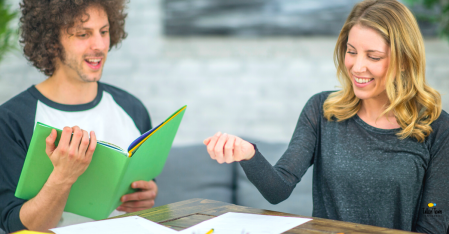
To make the game more challenging, they must list all 6 collocations before the other student can roll doubles. The other student is rolling the dice repeatedly while the first student is trying to list all their collocations. If the second student rolls doubles before they finish, they can collect points for as many collocations as they could produce. If they beat the roller and list them all, they get double the points.
5. Stand, Stood, Stood
This is a great segue into break time or stretch your legs during class. Ask all students to stand. Flip through the cards, one per student. The student must give the correct past forms of the verb. If they can, they can take a seat. If they make a mistake, they must remain standing and wait their turn to try again. Continue asking each student in rounds until all students are seated.
6. Body Movin’
Another kinesthetic practice that’s great for getting students moving at home. Choose 3 body moves for each tense. So, for example, arms up, arms down, jump. Students do the motions while calling out each tense. TAKE (arms up), TOOK (arms down), TAKEN (jump). Once they have the hang of it, let them choose more actions for each set of cards.

7. Truth or Lie
Are your students good at lying? This activity is always sure to be a big hit, but better for intermediate and advanced levels due to the use of perfect forms and vocabulary requirements.
Choose a verb from the deck and ask a student a Have you ever… question. The student must always answer, Yes, I have. Then the class will ask follow-up questions to determine whether the student is telling the truth or lying. After questioning the student, the truth is revealed.
Click here for a list of over 100 Have You Ever questions for classroom use!
8. Storytelling
Use 5-15 cards depending on the size of your class. Flip the first card for student 1, who begins a story using that verb. For example,
Once upon a time, there was a girl who loved to TAKE photos…
Student 2 gets the next random card and must continue the story using that verb.
…but one day, someone STOLE her camera!
Continue until all students have added to the story. The last student must give the story a good ending. When all the cards have been used in the story, flip through the cards again, and have them try to re-create the story in spoken English or on paper.
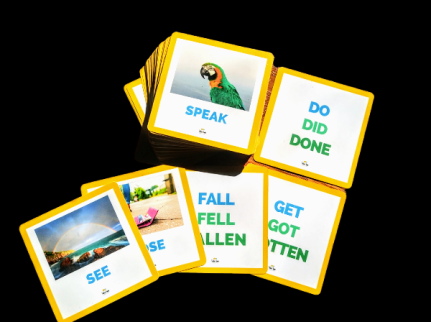
Flashy and Fun
Regardless of the activities you decide to use, don’t stop flipping! Try to work in a few minutes of flashcard practice every day. Don’t feel like you need to do the whole deck in one sitting. Choose 10 cards per week and build from there, with twenty the next week. The verbs you choose could be related to your topic for that week, or related to each other, as in participle forms that end in -en, e.g. shaken, taken, fallen, etc. I’m sure there are many other ways to use irregular verb flashcards that I haven’t thought of yet. Do you have any to add? I’d love to hear your flashy ideas in the comments!
About My Flashcards
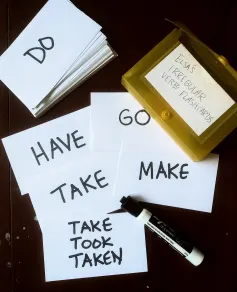
When the pandemic started, our school transitioned to online learning overnight. Many of my teaching resources and games had all been left back at school and were now covered in Covid. This included my trusty deck of irregular verb flashcards, which I had hand-printed on index cards with a permanent marker years ago. They weren’t pretty, but they worked.
I knew I would need to make a new deck of flashcards right away. This time, instead of reaching for the marker and index cards again, I jumped on Canva and started designing a deck of common irregular verb flashcards online.
I wanted to create a deck that would reflect the changes that were taking place, both academically and socially. My new deck of photo flashcards is bright, colorful, diverse, and positively conversational. I’m kind of in love with them.
I have two versions of these cards. One is a finished, printed deck of 3.5″ cards. The other is a PDF for those who want to print from home and laminate. You can check them both out in my Etsy shop here.
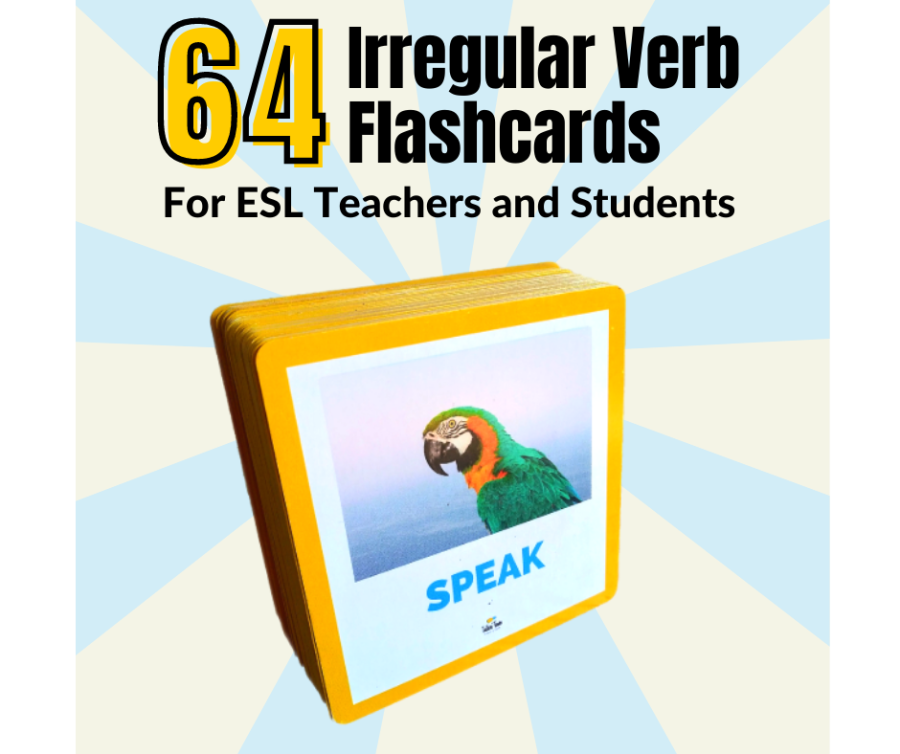
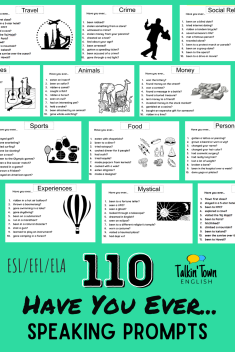

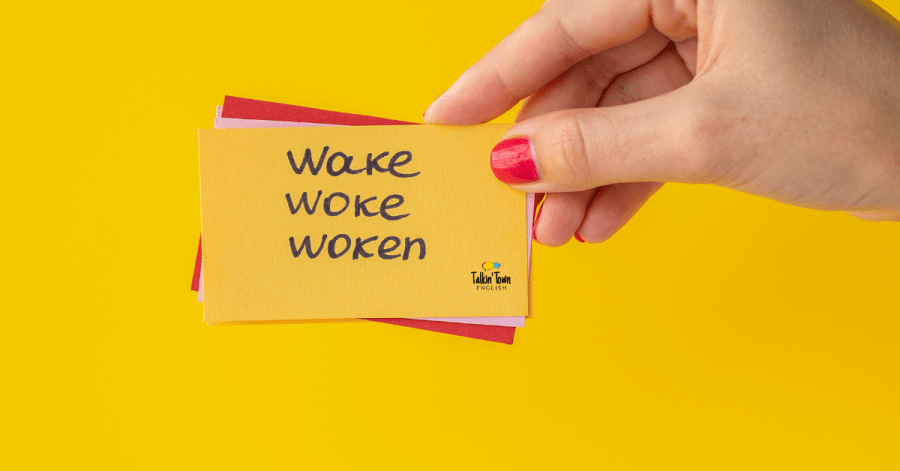
One thought on “8 Flashy Ways To Use Flashcards for Online ESL”
Comments are closed.